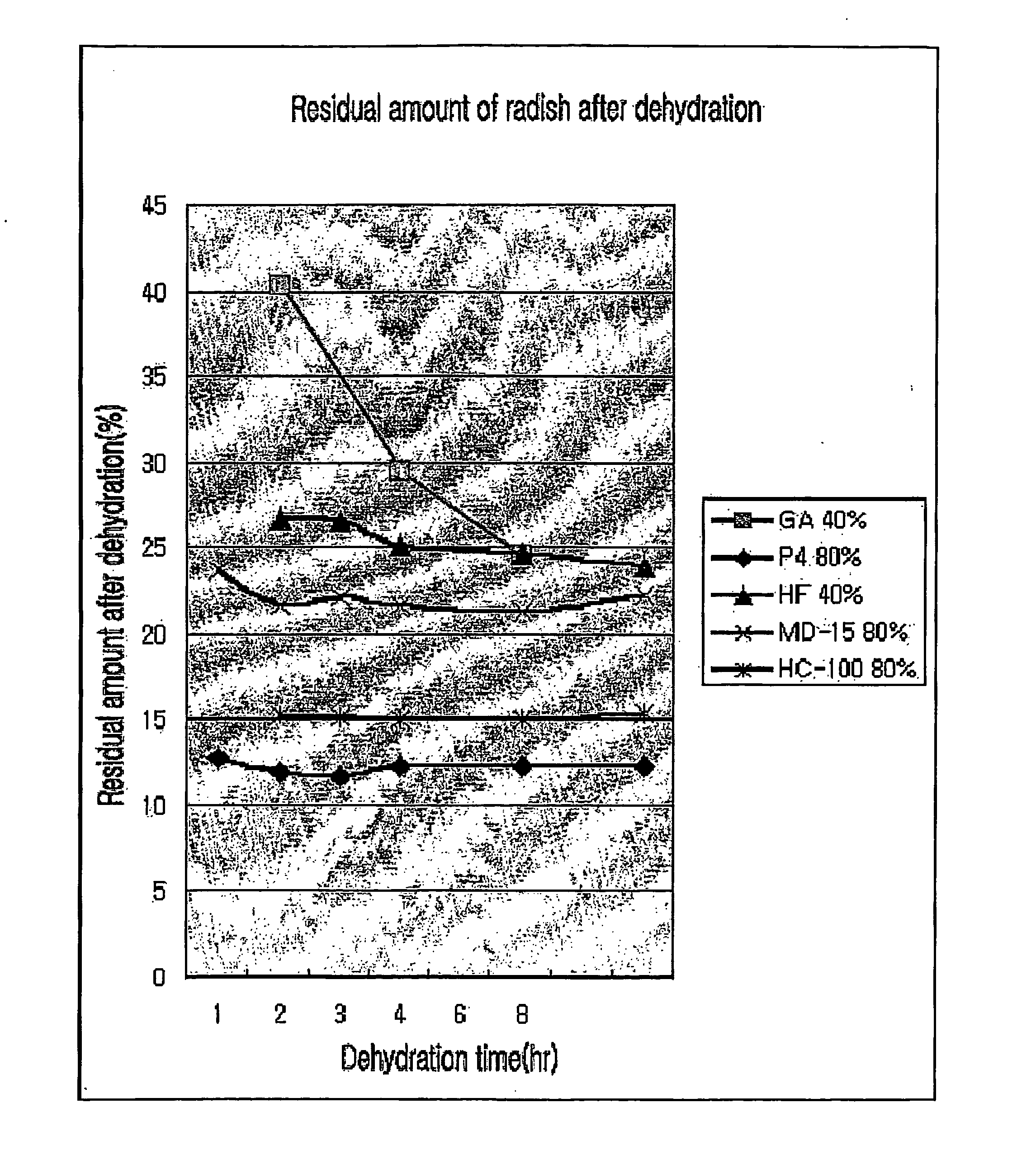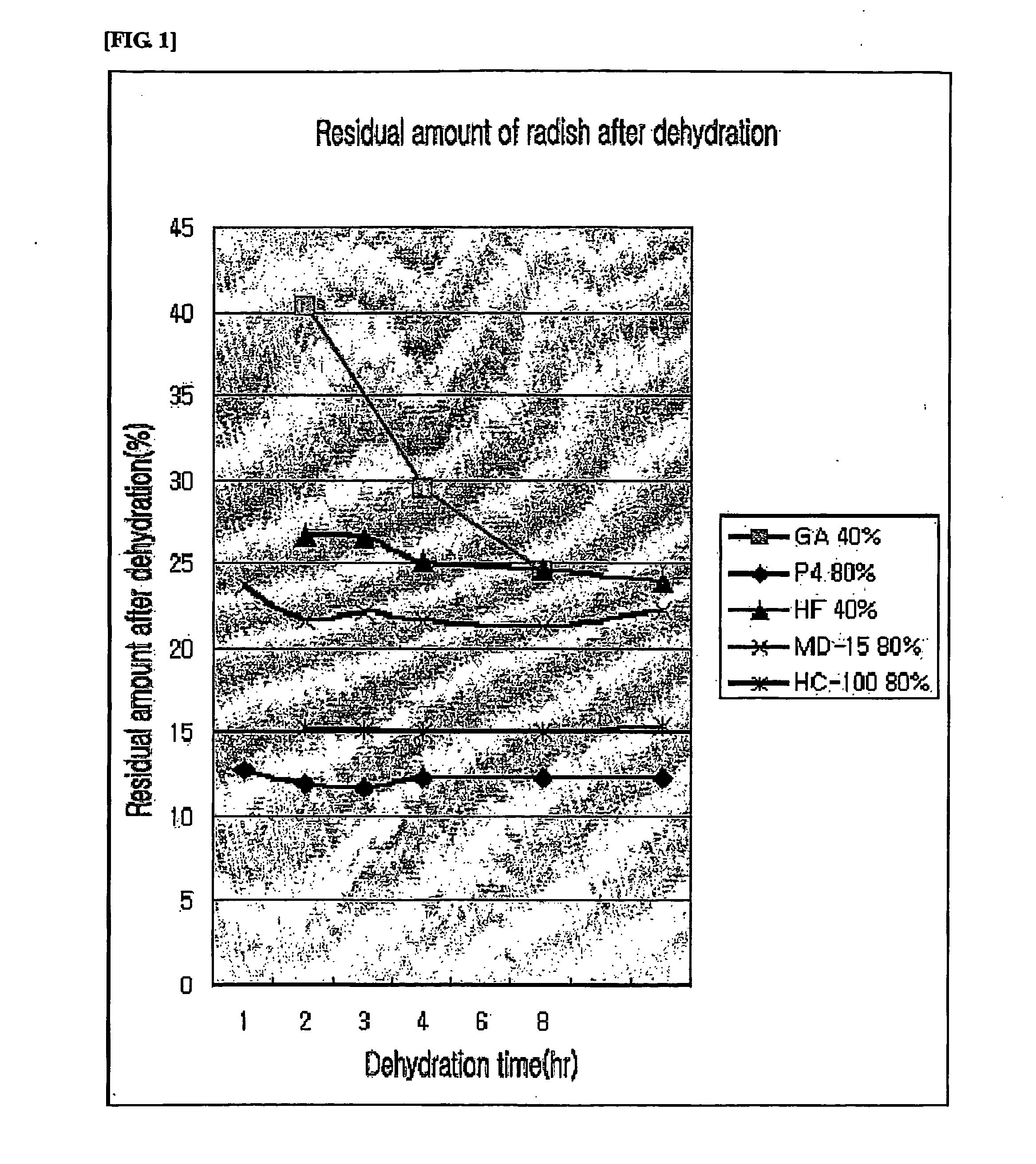Molecular press dehydrating agents for vegetative tissue comprising starch hydorlysates or their derivatives
a technology of molecular press and vegetative tissues, which is applied in the field of molecular press dehydrating agents and molecular press dehydrating methods for vegetative tissues, can solve the problems of small dehydration, adverse effects on the taste and quality of dehydrated tissues, and reduce the rehydration quality of tissues, so as to reduce the viscosity and low viscosity , the effect of drying easy
- Summary
- Abstract
- Description
- Claims
- Application Information
AI Technical Summary
Benefits of technology
Problems solved by technology
Method used
Image
Examples
example 1
Dehydration of Radish Using the Molecular Press Dehydrating Agents of the Present Invention
[0060] Radish tissues were dehydrated using the molecular press dehydrating agents of the present invention.
[0061] As the molecular press dehydrating agents of the present invention, maltodextrin (DE 15), a modified starch which main component is a starch sodium octenyl succinate (HI-CAP 100, National Starch & Chemical) and a foaming agent which main component is sodium caseinate of low molecular weight (Hyfoama DS, Quest) were used.
[0062] In order to investigate capability of molecular press dehydration of dehydrating agents in the present invention, an experiment of dehydration with radish was conducted together with PEG 4000 and gum arabic which are existing molecular dehydrating agents.
[0063] The dehydrating agents in the amount of 40-80% of that of radish tissues were mixed with radish tissues that were sliced to have a thickness of 1 mm, and the mixtures were left to dehydrate for an...
example 2
Dehydration Experiments of Other Materials Using the Molecular Press Dehydrating Agents of the Present Invention
[0066] In order to confirm utilization of molecular press dehydrating agent of the present invention, experiments were conducted with a wide variety of vegetable materials such as aloe, cucumber, potato, apple, etc.
[0067] The experiments were conducted by the same method as the above experiment described in example 1, and the result is shown in Table 2.
TABLE 2Amount ofResidualDried wt. toDehydratingdehydratingDehydrationamount afterdehydratedagentagent, %Plant materialtime, hoursdehydration, %tissue, %PEG 400080aloe207.752.1cucumber47.854.3potato526.078.1apple517.657.7Gum arabic40aloe2017.124.1cucumber514.922.6potato2442.146.9apple2424.636.6Maltodextrin80aloe208.947.1(DE 15)cucumber410.945.9potato2432.871.4apple520.754.9Starch80aloe208.548.1sodiumcucumber59.650.4octenylpotato2430.670.5succinateapple520.955.7Sodium40aloe2018.834.1caseinate ofcucumber2316.638.2low MWpota...
example 3
Identification of the Quality of Dehydrated Product Obtained Using the Molecular Press Dehydrating Agents of the Present Invention
[0072] The quality of dehydrated product obtained using molecular press dehydrating agents of the present invention was identified with dehydrated exudate and dehydrated / dried tissue separately.
[0073] 1) Dehydrated Exudate
[0074] By the same method as the above example 1 aloe, cucumber, apple and potato were dehydrated using the molecular press dehydrating agent of the present invention and the obtained exudates were compared in color, odor and taste, etc. after storage of seven days, and the result is shown in Table 3.
TABLE 3PlantDehydratingmaterialagentColorOdorTasteOthersAloeP4PinkLight grassyGreasy,Flavor is besttastelessGADark pink,Heavy grassylittle cloudyDE-15LightVery lightSlightly bitterNo change ingreenishgrassycolorbrownHC-100Light pink,Grassy, floralturbidHFPinky brown,Baking sodacloudyCucumberP4Very lightRefreshingFlavor is bestgreencucum...
PUM
| Property | Measurement | Unit |
|---|---|---|
| size | aaaaa | aaaaa |
| diameter | aaaaa | aaaaa |
| temperature | aaaaa | aaaaa |
Abstract
Description
Claims
Application Information
 Login to View More
Login to View More - R&D
- Intellectual Property
- Life Sciences
- Materials
- Tech Scout
- Unparalleled Data Quality
- Higher Quality Content
- 60% Fewer Hallucinations
Browse by: Latest US Patents, China's latest patents, Technical Efficacy Thesaurus, Application Domain, Technology Topic, Popular Technical Reports.
© 2025 PatSnap. All rights reserved.Legal|Privacy policy|Modern Slavery Act Transparency Statement|Sitemap|About US| Contact US: help@patsnap.com


